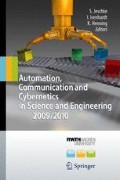Abstract
The emergence of the Social Web offers new opportunities for scientists to explore open virtual communities. Various approaches have appeared in terms of statistical evaluation, descriptive studies and network analyses, which pursue an enhanced understanding of existing mechanisms developing from the interplay of technical and social infrastructures. Unfortunately, at the moment, all these approaches are separate and no integrated approach exists. This gap is filled by our proposal of a concept which is composed of a universal description model, temporal network definitions, and a measurement system. The approach addresses the necessary interpretation of Social Web communities as dynamic systems. In addition to the explicated models, a software tool is briefly introduced employing the specified models. Furthermore, a scenario is used where an extract from the Wikipedia database shows the practical application of the software.
Access this chapter
Tax calculation will be finalised at checkout
Purchases are for personal use only
Preview
Unable to display preview. Download preview PDF.
References
B. Thomas Adler, Luca de Alfaro, Ian Pye, and Vishwanath Raman. MeasuringAuthor Contributions to the Wikipedia. Technical report, School of Engineering, University of California, May 2008.
Robert P. Biuk-Aghai. Visualizing Co-Authorship Networks in Online Wikipedia. Communications and Information Technologies, 2006. ISCIT ’06. International Symposium on, pages 737–742, 18 2006-Sept. 20 2006.
Luciana Buriol, Carlos Castillo, Debora Donato, Stefano Leonardi, and Stefano Millozzi. Temporal Analysis of the Wikigraph. In Proceedings of the Web Intelligence Conference (WI 2006), pages 45–51, Los Alamitos, CA, USA, December 2006. IEEE Computer Society.
A. Capocci, V.D.P. Servedio, F. Colaiori, L.S. Buriol, D. Donato, S. Leonardi, and G. Caldarelli. Preferential attachment in the growth of social networks: the case ofWikipedia. Physical Review E, 74:036116–1–6, 2006.
Luciano da F. Costa, Francisco A. Rodrigues, Gonzalo Travieso, and P. R. VillasBoas. Characterization of complex networks: A survey of measurements. Advances in Physics, 56(1):167–242, January 2005.
Wikimedia Foundation. MediaWiki MySQL database layout. URL: http://www.mediawiki.org/wiki/Manual:Databaselayout, 2009.
Christian Fuchs. Knowledge Management in Self-Organizing Systems. Journal of Knowledge Management Practice, 5, 2004.
James Hendler, Nigel Shadbolt, Wendy Hall, Tim Berners-Lee, and DanielWeitzner. Web science: an interdisciplinary approach to understanding the web. Commun. ACM, 51(7):60–69, 2008.
A. Kittur, E. H. Chi, B. A. Pendleton, B. Suh, and T. Mytkowicz. Power of the fewvs. wisdom of the crowd: Wikipedia and the rise of the bourgeoisie. In 25th Annual ACM Conference on Human Factors in Computing Systems (CHI 2007), San Jose, CA., 2007.
Hyunmo Kang, Catherine Plaisant, Bongshin Lee, and Benjamin B. Bederson. NetLens: iterative exploration of content-actor network data. Information Visualization, 6:18–31, 2007.
Fawad Nazir and Hideaki Takeda. Extraction and analysis of tripartite relationshipsfrom Wikipedia. In IEEE International Symposium on Technology and Society, ISTAS 2008, pages 1–13, Sydney (Australia), June 2008.
Bongwon Suh, E.H. Chi, B.A. Pendleton, and A. Kittur. Us vs. Them: UnderstandingSocial Dynamics in Wikipedia with Revert Graph Visualizations. Visual Analytics Science and Technology, 2007. VAST 2007. IEEE Symposium on, pages 163–170, 30 2007-Nov. 1 2007.
B. Stvilia, M. B. Twidale, L. C. Smith, and L. Gasser. Assessing information qualityof a community-based encyclopedia. In Proceedings of the International Conference on Information Quality - ICIQ 2005, pages 442–454, 2005.
Fernanda B. Viegas, Martin Wattenberg, Jesse Kriss, and Frank van Ham. Talk BeforeYou Type: Coordination in Wikipedia. In 40th Annual Hawaii International Conference on Systems Science (HICSS), pages 78–78, Jan. 2007.
MartinWattenberg, Fernanda Viégas, and Katherine Hollenbach. Visualizing Activityon Wikipedia with Chromograms. Human-Computer Interaction – INTERACT 2007, pages 272–287, 2007.
V. Zlatic, M. Bovzivcevic, H. Stefanvcic, and M. Domazet. Wikipedias: Collaborativeweb-based encyclopedias as complex networks. Physical Review E, 74, 2006.
Author information
Authors and Affiliations
Corresponding author
Editor information
Editors and Affiliations
Rights and permissions
Copyright information
© 2011 Springer-Verlag Berlin Heidelberg
About this paper
Cite this paper
Müller, C., Meuthrath, B., Jeschke, S. (2011). Defining a universal actor content-element model for exploring social and information networks considering the temporal dynamic. In: Jeschke, S., Isenhardt, I., Henning, K. (eds) Automation, Communication and Cybernetics in Science and Engineering 2009/2010. Springer, Berlin, Heidelberg. https://doi.org/10.1007/978-3-642-16208-4_11
Download citation
DOI: https://doi.org/10.1007/978-3-642-16208-4_11
Published:
Publisher Name: Springer, Berlin, Heidelberg
Print ISBN: 978-3-642-16207-7
Online ISBN: 978-3-642-16208-4
eBook Packages: Mathematics and StatisticsMathematics and Statistics (R0)

